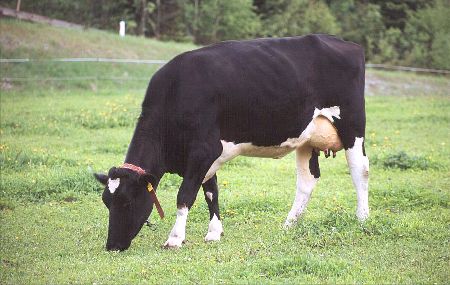The project will determine the extent of mobilization/retention with different energy supplies over the course of an entire lactation cycle.
At the beginning of lactation (in the phase of highest nutrient requirements and lowest feed intake) the cow mobilizes nutrients (especially fat reserves) to cover the needs for milk synthesis. The second third of lactation is characterized by a relatively balanced energy balance. In the last phase of lactation and especially in high pregnancy, nutrients are retained (refilled), which are available for mobilization again at the beginning of the next lactation, etc. The extent of mobilization depends on the energy supply (proportion of concentrated feed, basic feed quality) and the performance potential of the cow (POND 1984, CHILLIARD 1987, CHILLIARD et al. 1991, CHILLIARD et al. 2000, BELL & BAUMAN 1994, McNAMARA 1994, SCHWAGERSUTER et al. 2001).
This production cycle of mobilization and retention, found in all female mammals, has positive and negative aspects. From an evolutionary perspective, it was particularly advantageous for the survival rate of the young that their nutrition via mother's milk is (partly) independent of the nutrient supply of the mother (because of their ability to mobilize). This genetically and evolutionarily deeply anchored ability to mobilize can also be used as an advantage under modern conditions of milk production, in that the nutrients required for milk synthesis do not have to be completely covered by the feed, but are partly provided for by mobilization. As a result, rations with a lower proportion of concentrated feed are possible (lower stress on the rumen [acidosis, ruminant welfare, etc.], more species-appropriate rations that emphasize basic feed, ecological and economic aspects [purchase of inputs, import of nutrients into the farm]). However, this is contradicted by the fact that during the mobilization of fat, metabolites (β-hydroxybutyric acid, acetone, acetate-acetate) which are highly stressful or damaging to the metabolism occur and which cause the economically very important clinical picture of ketosis (acetonemia). Decrease in performance, frequent loss of animals).
The project will determine the extent of mobilization/retention with different energy supplies over the course of an entire lactation cycle. This is done directly in so-called respiration chambers (parallel experiment at the University of Hohenheim) or through indirect or estimation methods (D2O, 12C/13C isotopes; body condition score). At the same time, the effects on metabolism and claw health are monitored precisely. The optimal energy level in dairy cattle feeding can be derived from the results and this project thus addresses a central issue in dairy cattle feeding (EDMONSON et al. 1989, GEARHART & CURTIS 1990, RUEGG & MILTON 1995, GILLUND et al. 2001, PRYCE et al. 2001). The question results in the following experimental plan:
Experimental plan: Concentrated feed proportions in the lactation phases
|
Energy level |
1st third of lactation |
2nd third of lactation |
3rd third of lactation |
Dry period |
|
Low |
20 |
10 |
20 |
15 |
|
Medium |
40 |
30 |
20 |
15 |
|
High |
60 |
50 |
20 |
15 |
63 cows from the LFZ Raumberg-Gumpenstein dairy herd are used for the experiment. The experimental plan shows that the different energy supply in the individual lactation phases is achieved by different concentrate proportions. Feeding at the end of lactation and during the dry period is the same in all groups in order to be able to determine the influence of the energy supply at the start of lactation on the reaction of all experimental parameters (feed intake, nutrient retention, metabolism, etc.).
Further information on project management can be found in the database for research and sustainable development (Dafne) -> Link







